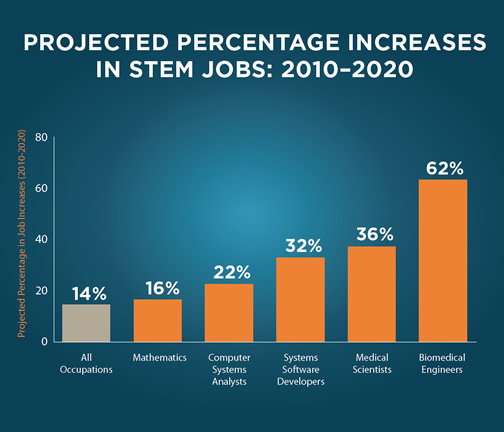This post is authored by Peggie Koon, president of ISA 2014.
In last month’s ISA Insights article I mentioned I will complete a series of articles reviewing the 10 trends impacting ISA. Last month we looked at Cybersecurity and this month we’ll take a closer look at the STEM education initiative. Virtually all ISA members and automation professionals have benefited from their education in science, technology, engineering and mathematics (STEM). Even so, are you doing enough to promote interest in and the importance of STEM education and STEM careers? After all, STEM education is essential to cultivating a new generation of automation  professionals and to encouraging greater worldwide discovery and innovation.
professionals and to encouraging greater worldwide discovery and innovation.
This month’s article begins with a definition of STEM education. I’ll then share how STEM education shaped my life and career. Next, we’ll highlight what ISA, AF and others are doing to promote this important initiative. And finally, we’ll look at how you can help serve in support of the effort.
What is STEM education? In the article “Why STEM education is important,” Francis Eberle, Ph. D., as executive director of the National Science Teachers Association, wrote: “We define STEM education as the preparation of students in competencies and skills in the four disciplines (science, technology, engineering, and math). A successful STEM education provides students with science, math, and engineering/technology in sequences that build upon each other and can be used with real-world applications.”
How did a STEM education shape my life and career? My family is rooted in science and mathematics. There were 10 of us and about half were liberal arts majors and the other half concentrated on math and science. From physics, to pure mathematics, to electrical engineering and chemical engineering, we loved math and the sciences, excelled in the disciplines, and were fortunate enough to have attended schools with excellent teachers and a strong emphasis on science, technology, engineering, and math.
In addition, our teachers and counselors found programs to augment our curriculum—to help enhance our excitement and interest. For instance, my older brother's chemistry teacher enrolled him and a group of his classmates in a summer physics program at Oak Ridge National Laboratories. He pursued a career in physics, obtaining a double degree in physics and mathematics from the Massachusetts Institute of Technology (MIT) and a doctorate degree in high energy nuclear physics from Princeton.
As a rising senior in high school I attended the National Science Foundation’s summer science training program (SSTP) a special program at LSU for juniors in high schools across the nation who were “gifted” in the sciences. The same woman who encouraged my brother—my high school chemistry teacher—was responsible for making our class aware of the program. She facilitated the required testing and helped us submit our applications so we would have a chance to participate. She had a very positive impact on my future educational and career choices. I majored in mathematics as an undergraduate, studied industrial and systems engineering in graduate school, and received my doctorate degree in management information systems or IT systems.
The teacher, Mrs. Otwell, was a subject matter expert (SME) who knew and loved chemistry, math, and physics. She shared her knowledge and love of the disciplines in such a powerful practical way that it was contagious! All of us who were fortunate enough to come through her classroom loved chemistry, math, and the sciences, too; and because of her efforts we understood the importance of science and math to our society and our nation. As I have traveled and interacted with peers in ISA and other educational and professional organizations I hear the same sorts of stories about their experiences…their curriculums, teachers, and their levels of engagement in promoting STEM.
Our STEM education experiences corroborate President Obama's statement: “The quality of math and science teachers is the most important single factor influencing whether students will succeed or fail in science, technology, engineering, and math.”
Why is STEM education important? According to Dr. Eberle: “STEM education creates critical thinkers, increases science literacy, and enables the next generation of innovators. Innovation leads to new products and processes that sustain our economy. This innovation and science literacy depends on a solid knowledge base in the STEM areas. It is clear that most jobs of the future will require a basic understanding of math and science. Ten-year employment projections by the US Department of Labor show that of the 20 fastest-growing occupations projected for 2014, 15 of them require significant mathematics or science preparation.”
The chart below from the U.S. Department of Education website confirms Dr. Eberle’s employment projections:
 Eberle says "it is imperative that as a nation, we make STEM education a top priority. We have a lot of work to do.”
Eberle says "it is imperative that as a nation, we make STEM education a top priority. We have a lot of work to do.”
According to the www.ed.gov/stem site, "Only 16 percent of American high school seniors are proficient in mathematics and interested in a STEM career. Even among those who do go on to pursue a college major in the STEM fields, only about half choose to work in a related career. The US is falling behind internationally, ranking 25th in mathematics and 17th in science among industrialized nations. In our competitive global economy, this situation is unacceptable”.
What are ISA and the Automation Federation doing to support STEM education initiatives? ISA and its umbrella organization, the Automation Federation, have been involved in STEM education and other workforce development initiatives for many years. In his article, “Carpe diem America”, Todd Lucey, as general manager of Endress+Hauser Sales Center USA, wrote: "The cradle-to-grave approach, led by the Automation Federation’s Workforce Development plan, stresses the importance of strengthening STEM. Working toward the same goal, we can join the efforts headed by Project Lead the Way—a provider of STEM education curricular programs used in middle and high schools across the US—to create a greater awareness of STEM-related careers in the field of automation.”
The AF works to advance the science and engineering of automation technologies, promote the automation profession, and develop the education and training programs that will prepare and inspire a new generation of automation professionals. The AF is an active participant in a growing national movement—involving leaders in government, education and private industry—focused on increasing students’ interest and skills in science, technology, engineering and mathematics (STEM) within America’s educational system." Click to read the full announcement.
One of the messages AF spreads on behalf of its member organizations is the importance of the automation profession and the need to develop the next generation of automation professionals. To build momentum and support for its workforce development initiatives—including the promotion of STEM education and the Automation Competency Model—AF is working to bring like-minded organizations together to create a stronger "voice.”
In March 2009, the Automation Federation also worked with the Piedmont Triad Partnership in organizing the first Technology Career Days event for high school students in the 12 counties comprising the Piedmont Triad region in North Carolina. Hundreds of high school students from 16 high schools visited 35 exhibits that highlighted automation and technology and provided hands-on learning activities. The students had the opportunity to discuss design, manufacturing, and logistics careers in fields from product design to automation to transportation.
In 2012, ISA and the AF partnered with Project Lead the Way in North Carolina and Pennsylvania to develop an automation course at Williamsport High school in Williamsport, Pennsylvania and at the Riverside High school in Durham, NC.
Furthermore, both ISA and the Automation Federation are also actively involved in FIRST®, an acronym which means “For Inspiration and Recognition in Science and Technology.” Founded in 1989, FIRST focuses on helping young people discover the excitement and rewards of science and technology. FIRST’s vision is to: "To transform our culture by creating a world where science and technology are celebrated and where young people dream of becoming science and technology leaders." Since 2010, the Automation Federation and ISA have enjoyed a global strategic alliance with FIRST to promote the importance of STEM in K-12 education.
What else might ISA do? During the recently held ISA Executive Summit, Society leaders identified cradle-to-grave advocacy of the automation profession as one of ISA’s five strategic goals. This means ISA will continue to work with AF organizations, government, educational institutions, and private industry to promote STEM education and to develop workforce training and professional development programs that support STEM careers.
What else is happening in STEM education across the US? President Obama has challenged governors, philanthropists, scientists, engineers, educators, and the private sector to join with him in a national campaign to find innovative new ways to recruit, train, reward, and retain teachers. The challenge resulted in a number of STEM education programs funded by states and private industry. Programs like GoldieBlox, Engineer Girl, and STEMspire are specifically targeted at STEM education for girls and women.
How do we make STEM education personal? How can you help? We need only follow the example of ISA Executive Director and CEO Pat Gouhin to learn how to become personally engaged in support of STEM education. Pat was vocal in encouraging ISA members and other automation professionals to recognize 2014 Engineers Week through outreach and volunteerism. And just a few weeks ago, Pat got personally involved at the FIRST Robotics Competition in Raleigh, NC. Pat volunteered his time—not just as an ISA leader, but as an automation professional, a parent, and a citizen concerned about our nation’s STEM education deficiency—to serve FIRST.
Next month, I will serve on a panel entitled “Customized Credentials Come of Age, at the US News Stem Solutions National Leadership Conference,” where we will “examine some of the standout credentials that employers value—and which lead to STEM jobs—as well as what’s necessary to engage more students and young professionals in these pathways.”
You can serve the STEM education initiative, too, by:
- Speaking at a classroom or after-school group
- Bringing students to your workplace or campus
- Spreading the need for STEM education and automation careers to colleagues
- Hosting a public event
- Publicizing your plans on the ISA blog or website
- Introducing your child’s school to FIRST or supporting GoldieBlox toys for the little girls in your life
- Getting the word out through social media on LinkedIn, FB, or Twitter
There’s no better time than right now to get involved!
About the Author Peggie Koon, Ph.D., is vice president of audience at Chronicle Media and The Augusta Chronicle, which are part of Morris Publishing Group, LLC, a privately held media company based in Augusta, Ga. Prior to joining Morris, Peggie spent more than 25 years developing IT systems for process automation and process control in a variety of industries, including automotive, nuclear defense, aerospace, nuclear reprocessing, thermal ceramics and textiles. Peggie assumed her first ISA leadership position in 1996 as membership chair of the Management Division and has held a variety of prominent leadership roles in the Society. She earned a bachelor's degree in mathematics from Smith College in Northampton, Mass. and completed graduate studies in industrial and systems engineering at the Georgia Institute of Technology. She received a doctorate in management information systems from Kennedy Western University in Cheyenne, Wyo.
Peggie Koon, Ph.D., is vice president of audience at Chronicle Media and The Augusta Chronicle, which are part of Morris Publishing Group, LLC, a privately held media company based in Augusta, Ga. Prior to joining Morris, Peggie spent more than 25 years developing IT systems for process automation and process control in a variety of industries, including automotive, nuclear defense, aerospace, nuclear reprocessing, thermal ceramics and textiles. Peggie assumed her first ISA leadership position in 1996 as membership chair of the Management Division and has held a variety of prominent leadership roles in the Society. She earned a bachelor's degree in mathematics from Smith College in Northampton, Mass. and completed graduate studies in industrial and systems engineering at the Georgia Institute of Technology. She received a doctorate in management information systems from Kennedy Western University in Cheyenne, Wyo.
A version of this article also has been published in ISA Insights.



